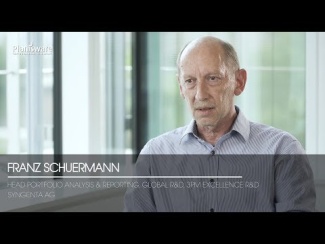An interview with Franz Schürmann, Portfolio Analysis & Reporting, Global R&D.
TRANSCRIPT
My name is Franz Schürmann. I work at Syngenta in Basel, Switzerland and I'm part of the P-Mac department which is an abbreviation for Project, Portfolio and Program Management Excellence. Specifically, I'm Portfolio Analyst and Reporting Manager.
What does Syngenta, and your department within the company do?
As number 1 worldwide in Crop Protection and number 3 in Seeds, Syngenta is active in 90 countries. We are responsible for defining and developing all Research and Development processes.
In your opinion, what are the specificities of project management in the agri-business industry?
The agribusiness industry has several specificities: Our projects are very complex. For instance, they can include up to 700 activities, multiple resources, and as we operate in a highly regulated environment, we must constantly adapt our plans to comply with any new regulation.
There are several axes we must take into account: for example: strategic goals, markets, indications (which means application domains, crops, geography climate and many more elements). That's what makes the whole matter so complex that we require a very flexible tool; but also a strong and powerful tool that can handle everything.
We have 2500 projects per year, which represent a total expenditure of about $ 1.3 billion per year.
How does Planisware help with these challenges?
We chose Planisware because it is a very flexible, modular system is that integrates international best practice standards, which is an absolute must with us.
We also decided that we needed a system that could and would grow with the maturity of our processes, and of our activities. And that is definitely something that Planisware can do.
Syngenta is a longtime Planisware customer. What have been the major milestones?
We rolled out our first system based on Planisware in 2008, and from the beginning, we had a lot of users. I think we already had more than 1000 users. A few years later, Planisware was already a strategic partner of Syngenta.
Since then, we have expanded to several implementations in different functions, not just in research and development and Planisware will certainly remain a strategic partner.
Could you give us some examples of how Planisware concretely helps Syngenta in its day-to-day business?
As I was saying earlier, because our portfolios are very complex, with tens of thousands of tasks, and thousands of projects with such a large budget, we needed a system that was capable at any time to give us transparency about all our projects.
But it also had to allow project managers to plan a project the way he is used to planning, without having first to transfer it to another tool, to plan, and then import it back.
Planisware does all of that for us in one integrated tool.
What do you like about Planisware in particular?
First of all, the modular design of Planisware means that we do not have to implement everything from the outset, but we can activate exactly the modules we need as the context requires.
Secondly, the breakdown structures – which is the hierarchy of elements inside the system – are very flexible and extremely useful for us, and they have the ability to link to each other. That's a very important point for us.
How do you see the future of Planisware at Syngenta in the coming years?
There is no doubt about that. Planisware has a strong position as one of our strategic partners.
In addition, we currently have several other implementations in progress and several others planned. That means we will certainly stay a customer for a long time and we will in the future be building many new systems based on Planisware.
One reason for this is that we want our systems to be fully integrated with each other, and using the same technology certainly facilitates that.

